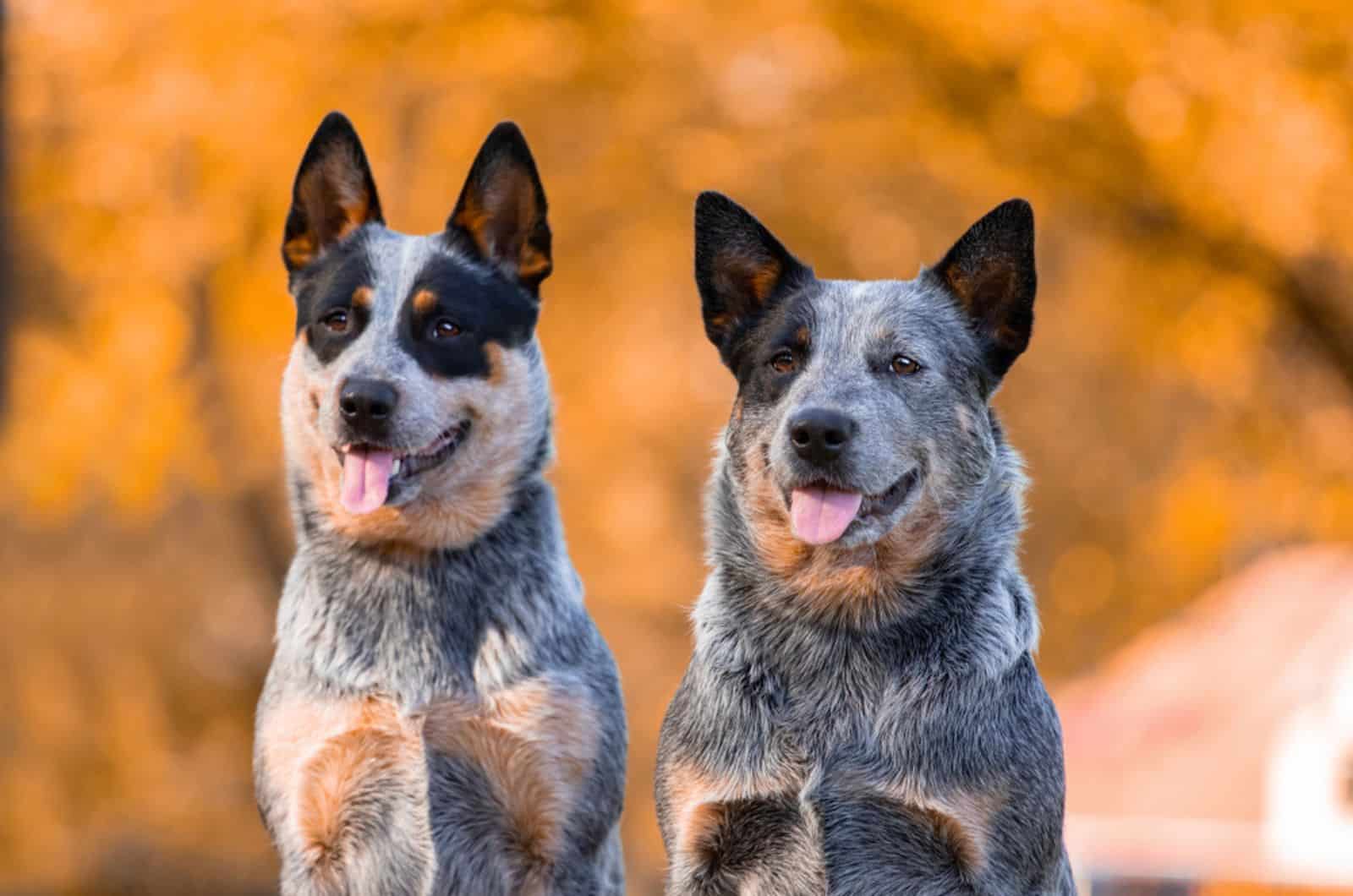It’s the Australian Cattle dog (or the Blue Heeler) and its stunning coat color. You can’t just explain the color of this dog in one word. You can say blue or red, but it’s much more than that.
It is certainly another trait that made these excellent working dogs so popular and unique. The first one is cattle herding and how exceptionally good they are at it.
But, you can’t imagine this dog without thinking of its unique-looking coat. Do they have spots all across their muscular body or are those mottled markings? Are they born with these markings or do they change their coat colors, similar to the Dalmatian dogs?
Well, they have five different coat colors and three markings to make the coat look even more unique and beautiful. We are going to take a look at all five Blue Heeler colors, and all the markings they can have.
We are talking about AKC (American Kennel Club)-accepted and registered coat colors and coat markings for this dog breed.
Let’s take a look.
5 Blue Heeler Colors
Also called Queensland Heeler or Red Heeler, this dog has a long history. Breed standards for this dog have changed from the first Australian Cattle Dog that was made by breeding blue-merle smooth Collies and Dingos.
Yes, this doggo has some wild blood! If you take a look at the conformation of a Blue Heeler, you can find traces of the Dingo’s posture and body shape even today. The Dingo is where this dog got its durability and short, thick coat.
But, what about the Blue Heeler colors? They didn’t come solely from Dingos. The color of Australia’s favorite cattle dog came from a Dalmatian dog as well, and most importantly, from smooth-coated Collies.
Their merle gene was the main influence in making mottled and speckled patterns (markings) on the double coat type of the blue and red Heeler dogs.
So, to get the unique coat color of the Australian Cattle dog, breeders used a number of breeds — Dingos, merle smooth Collies, Dalmatians, and black and tan Kelpie dogs.
The final outcome was five Blue Heeler colors and three markings. Of course, breeders didn’t look for these specific coat colors when they made the first dogs of this breed. They wanted to make a dog with high energy levels that could withstand Australia’s climate.
But, in the end, they got the best of both — beauty and stamina.
1. Blue
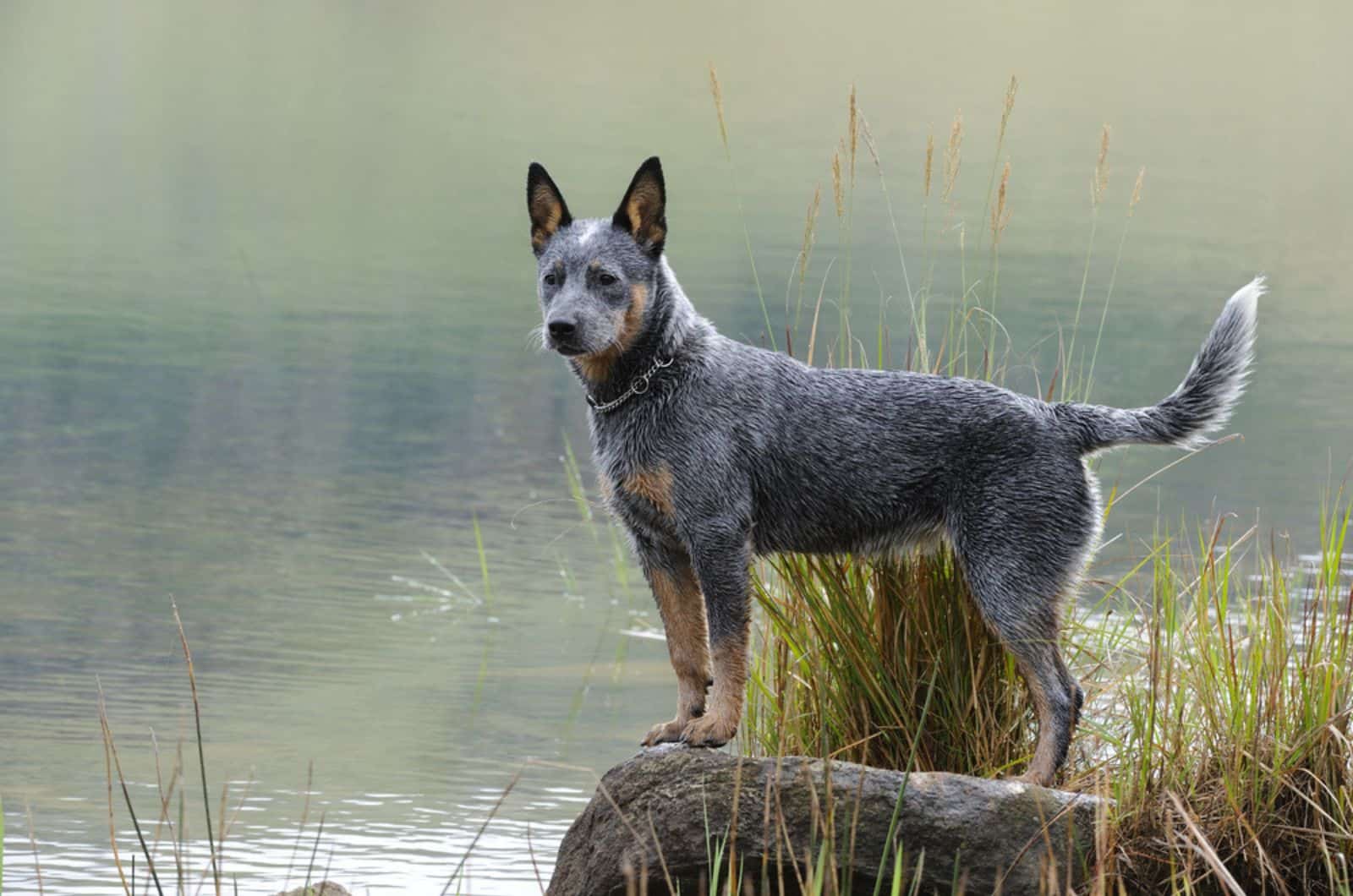
This is the most common Blue Heeler color. In essence, these dogs don’t have a true blue coat color. They have a base color, and white hairs that are intermingling with the base-colored hairs.
All Australian Cattle Dogs of blue coat color have a black undercoat. That is their base color — black. But, as mentioned, white hairs twist around the black hairs and make the dog appear to have a bluish color.
The number of white hairs dictates the Blue Heeler’s color. In other words, the number of white hairs dictates the shade of the blue color in these dogs.
If the white hairs are less present — the dog’s coat color will appear darker. If the white hairs are more present — the dog’s coat color will appear lighter. So, we can have darker and lighter blue-colored Australian Cattle Dogs.
What Is Considered Undesirable?
In the world of dog breeders, there are certain dog breed standards that they need to fulfill in order to register the dog as a Blue Heeler or an Australian Cattle Dog.
The Australian National Kennel Council (ANKC) is one of the official clubs that keeps track of the breeding, and makes sure that the breeding program is done by the official standards for this breed. Of course, they go by the AKC rules.
Every dog breed has official registered coat colors and markings. But, they also have some undesirable colors and/or patterns that show up in a litter from time to time.
For a blue-colored Australian Cattle Dog, the undesirable colors are too much or too few white hairs. If there are too many white hairs, the dog appears either white or white with blue markings, which is not acceptable.
If there are not enough white hairs, the dog will appear black. This is also an undesirable Blue Heeler color.
2. Blue Mottled
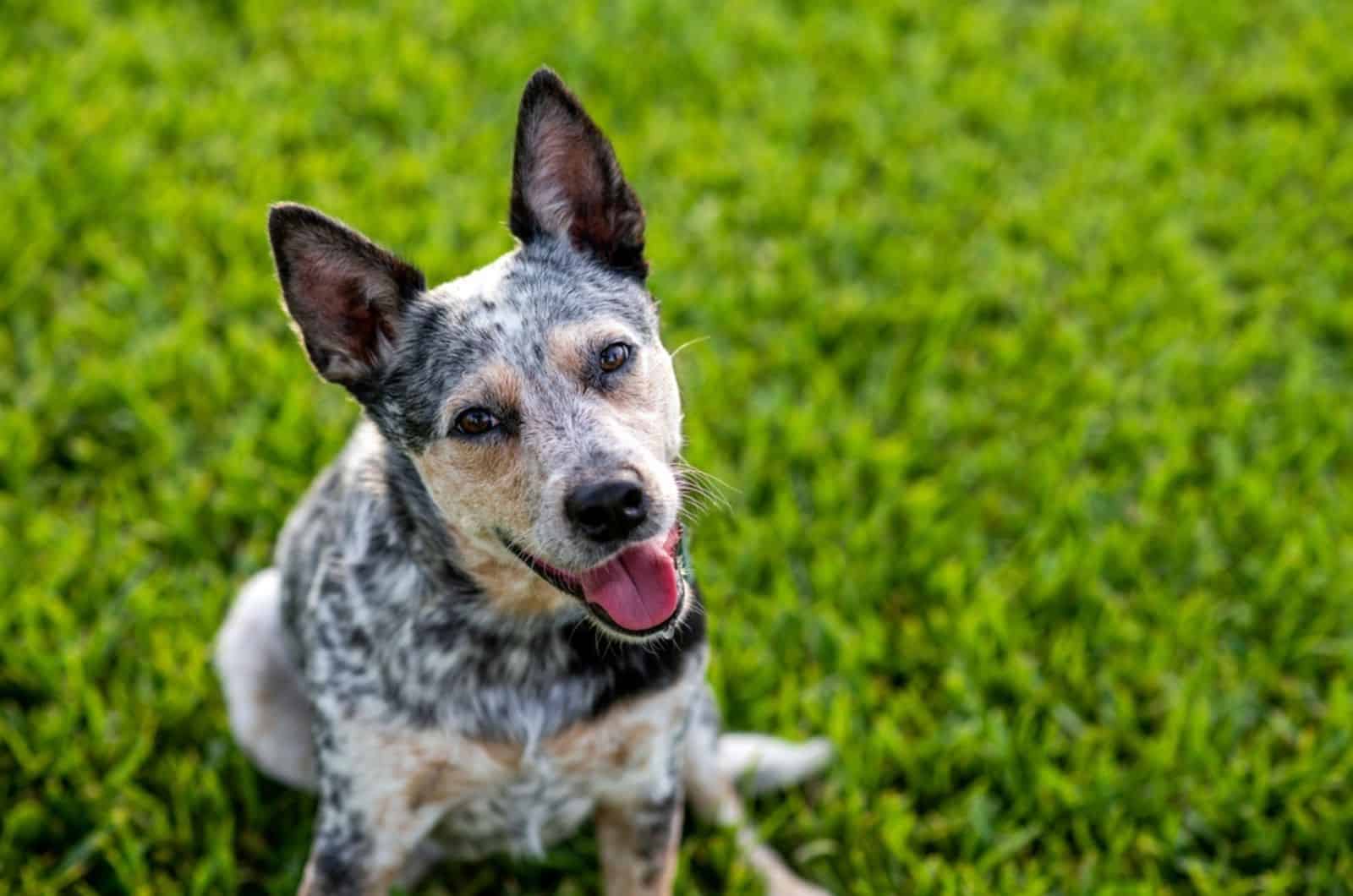
Once again, we are not talking about the real blue color, but about the black base color of the undercoat and the white hairs that show up in the outer coat.
In this Blue Heeler color, the white hairs appear in the form of mottles. They are no longer just strands of short hair that just give the coat a bluish appearance. They are now also gathered into irregular smudges all over the body.
These white-mottled shapes can be two inches or eleven inches in size. Anything above 11 and a half inches is considered a fault or an undesirable Blue Heeler coat color.
Ideally, a dog should appear to have equally-spread white mottled parts throughout the whole coat. Of course, this is not always possible to achieve.
That’s why the breeders are more focused on the size of the mottles. The smaller, the better — ideally less than five inches (12 cm). If the mottles are too big, the dog can appear white with just a few patches of blue color.
So, to sum it up — a blue mottled Blue Heeler color means the dog has:
- A black base coat color
- White hairs intertwining the black hairs
- White hairs grouped into mottles
What Is Considered Undesirable?
The mottled parts made by white hairs on the black base color of the undercoat should ideally be from 2 to 5 inches in size. If they are under 1 inch, then it’s no longer a blue mottled, but a blue speckled Australian Cattle Dog.
This Blue Heeler color is also quite popular, and because of that, there is more opportunity for “mistakes”. These are not really mistakes, but undesirable versions of the dog’s coat color. The undesirable versions of the blue mottled Blue Heeler color are:
- Mottled parts bigger than 12 inches
- Just a few blue patches on a white body
- Uneven big mottles ( which give the appearance of a bi-color variation)
3. Blue Speckled
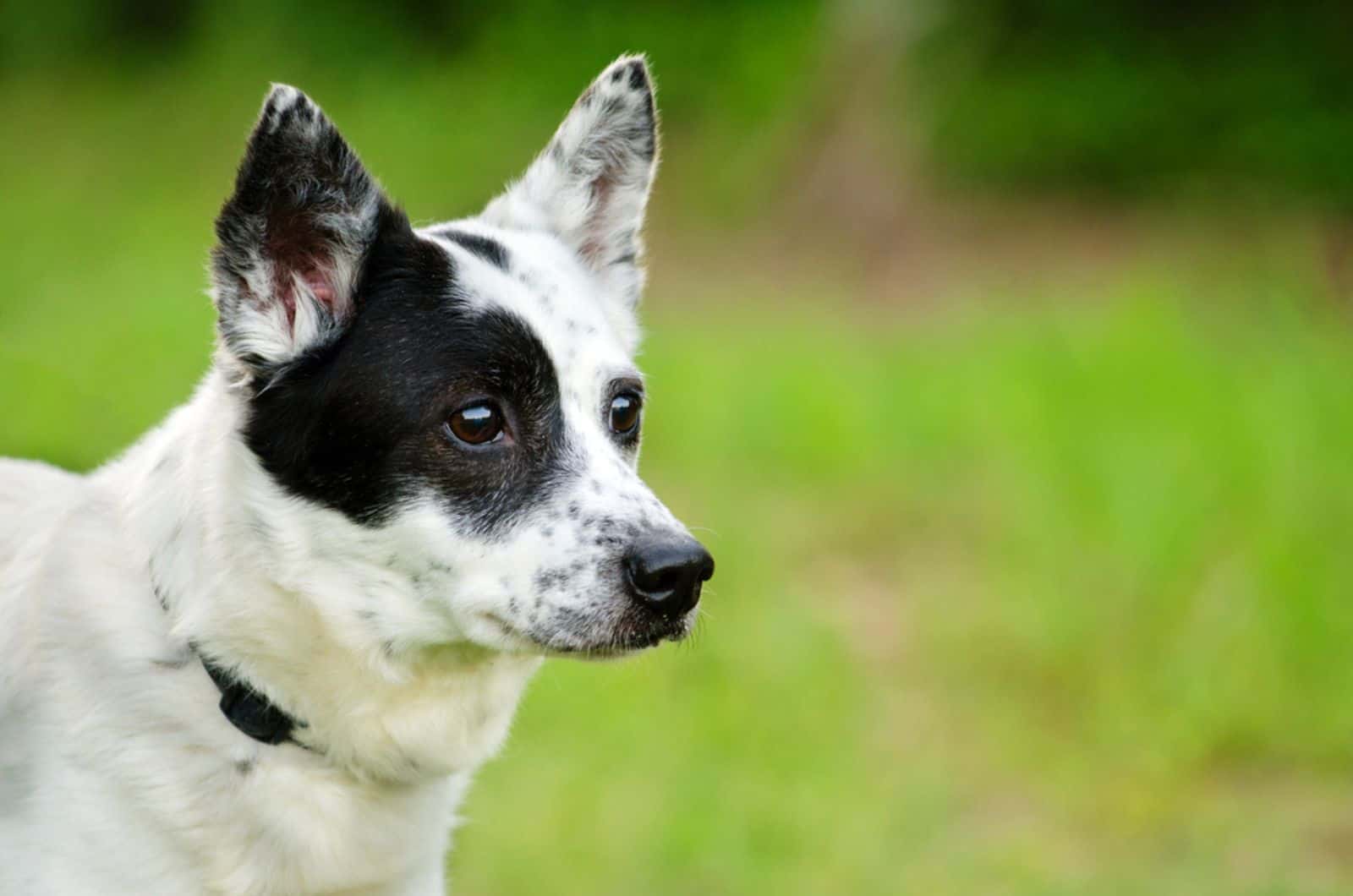
The blue speckled ACD has bluish fur with white speckles all over it. The size of the white speckles should be one inch or under it. They are not circular, but can still give an appearance of spots; hence, the fact that these dogs are often put into a spotted dog breed group.
People can often mistake a blue-speckled with a blue-mottled Blue Heeler color. But, when we put a blue-speckled Blue Heeler next to a blue-mottled Blue Heeler, the difference is obvious.
The reason for confusion lies in the size of the white forms made by white hairs in the outer coat. The base color is the same — it is black.
The confusion starts when the white speckles are bigger than one inch and turn into mottles. And, the other way around — when white mottles are less than one inch and turn into speckles.
The confusion also lies in the fact that there are a lot of Australian Cattle Dogs that don’t have evenly-distributed speckles or mottles of the same size throughout their coat. So, a dog can appear to have mottles on one part of the body and speckles on the other part.
Whether it’s a blue-mottled or a blue-speckled Blue Heeler color depends on the number of mottles and speckles on the body. If there are more speckles of approximately the same size — the color is blue speckled. And, if there are more mottled white shapes — the color is blue mottled.
What Is Considered Undesirable?
Similar to the undesirable version of the blue-mottled coat color, the size of the white speckles is the main source of undesirable coat color traits.
Here are some faulty color traits:
- A dog with big white spots
- A dog with big white patches
- Uneven big patches of white color (giving the appearance of a bi-color variation)
4. Red Speckled
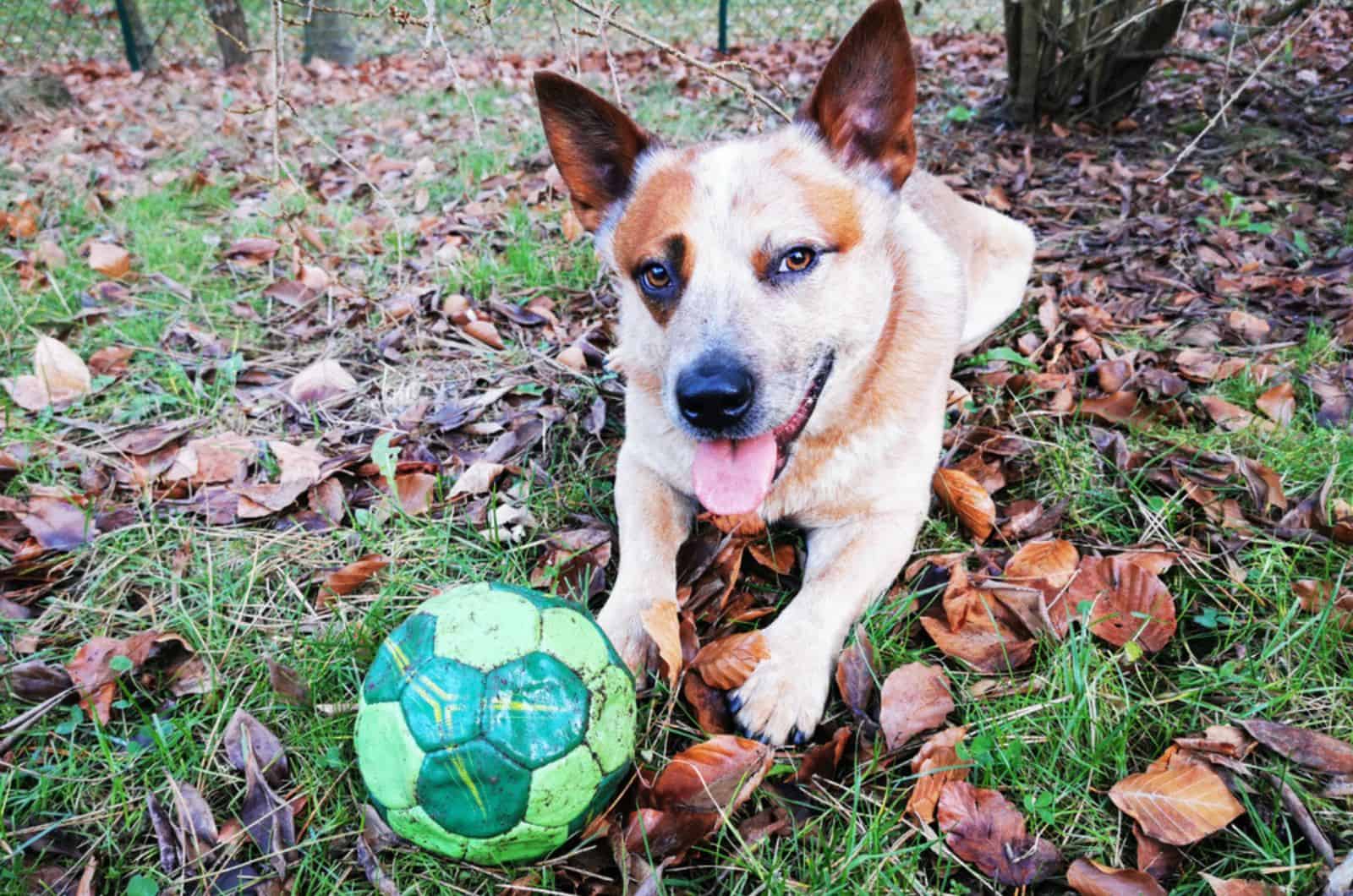
This is the fourth type of the five Blue Heeler colors. Dogs with this coat color are called red dogs. In essence, these dogs have a red base color and white hairs intertwined with them in their outer coat. Genetically, the base color is fawn or sable.
No matter if you breed these dogs in Canada, Australia, or the USA, the base color cannot be cream or white — it has to be red.
But, it also has to have white speckles spread as evenly as possible throughout the body. These white speckles are not bigger than one inch. Anything bigger than that gives the red-mottled coat color.
What Is Considered Undesirable?
Just the same as for blue dogs, the size of the white hairs (or the absence of them) dictate whether the color is undesirable or not.
The complete absence of white hairs is considered a strong fault. Such dogs are completely red without any white hair. Looking back to the days when farmers had to deal with wild dogs (dingoes), having a cattle dog breed that has the same color as a wild dog was out of the question.
That’s why the most undesirable type of Blue Heeler color was plain red without white hairs. On the other hand, too many white hairs were (and still are) considered undesirable.
So, faulty red speckled color variations are:
- Complete absence of white hairs
- Large speckles (more than 1 inch)
- White color with red spots
- Uneven big speckles (giving the appearance of a bi-color variant)
5. Red Mottled
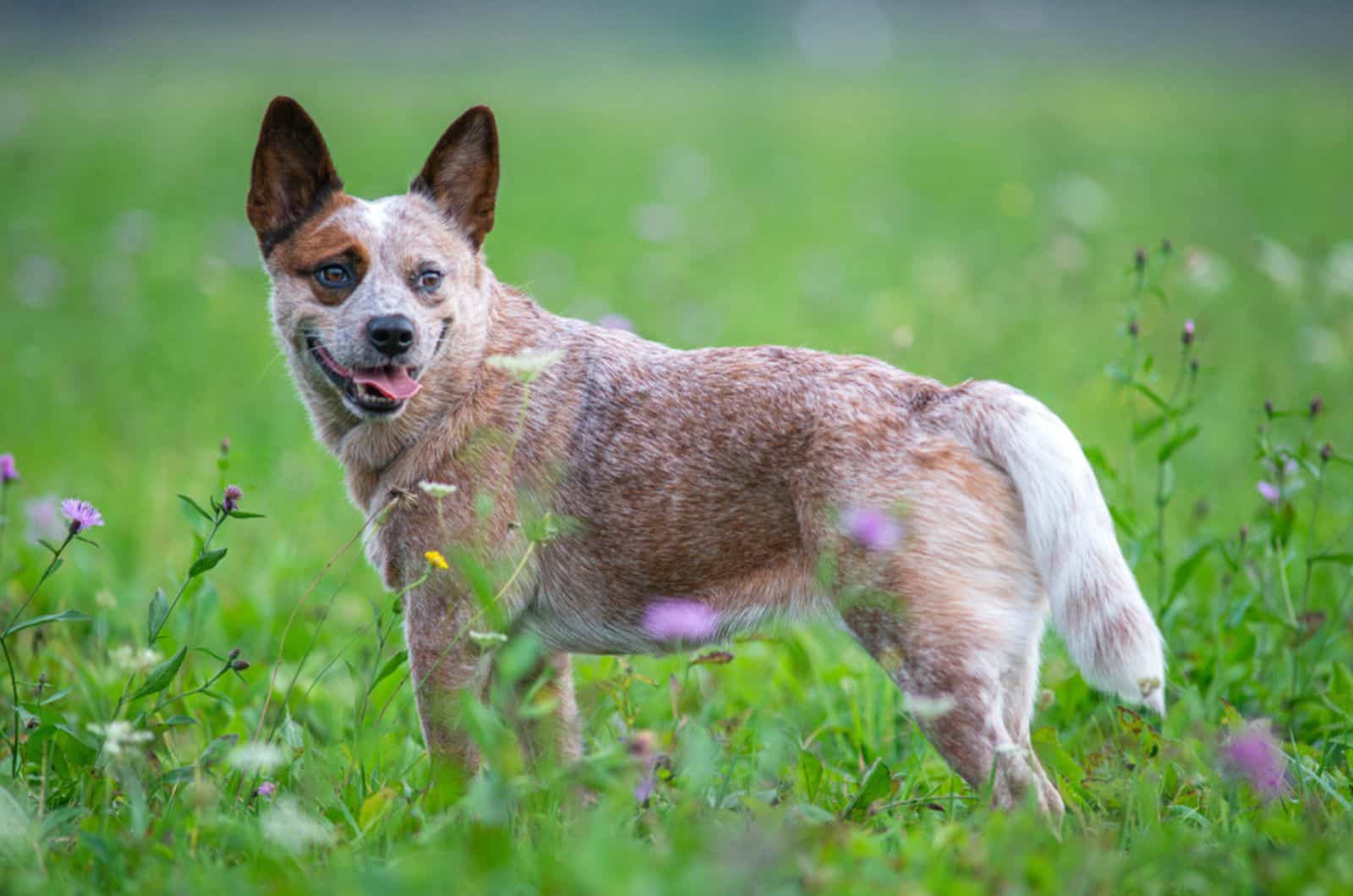
And, the last officially accepted and registered Blue Heeler color is red mottled. These dogs are also called red dogs. Just like in blue dogs, these dogs have mottles of white hair more or less evenly spread all over their body.
The mottles are ideally between 2 and 5 inches in size. Anything less than 1 inch means the dog has a red-speckled coat color. The white mottled parts can be bigger than five inches — up to eleven inches.
But, anything bigger than 11 to 12 inches is not desirable. These dogs have the same white hair mottles as the blue-mottled Australian Cattle Dog. The difference is… you’ve guessed it… in the base coat color. These dogs have a red base color, and the blue dogs have a black base color.
The undesirable coat color variation of this Blue Heeler color is the same as for the blue-mottled dogs. It’s the size of the white mottles. They shouldn’t be big patches of white or unevenly mottled.
Blue Heeler Markings
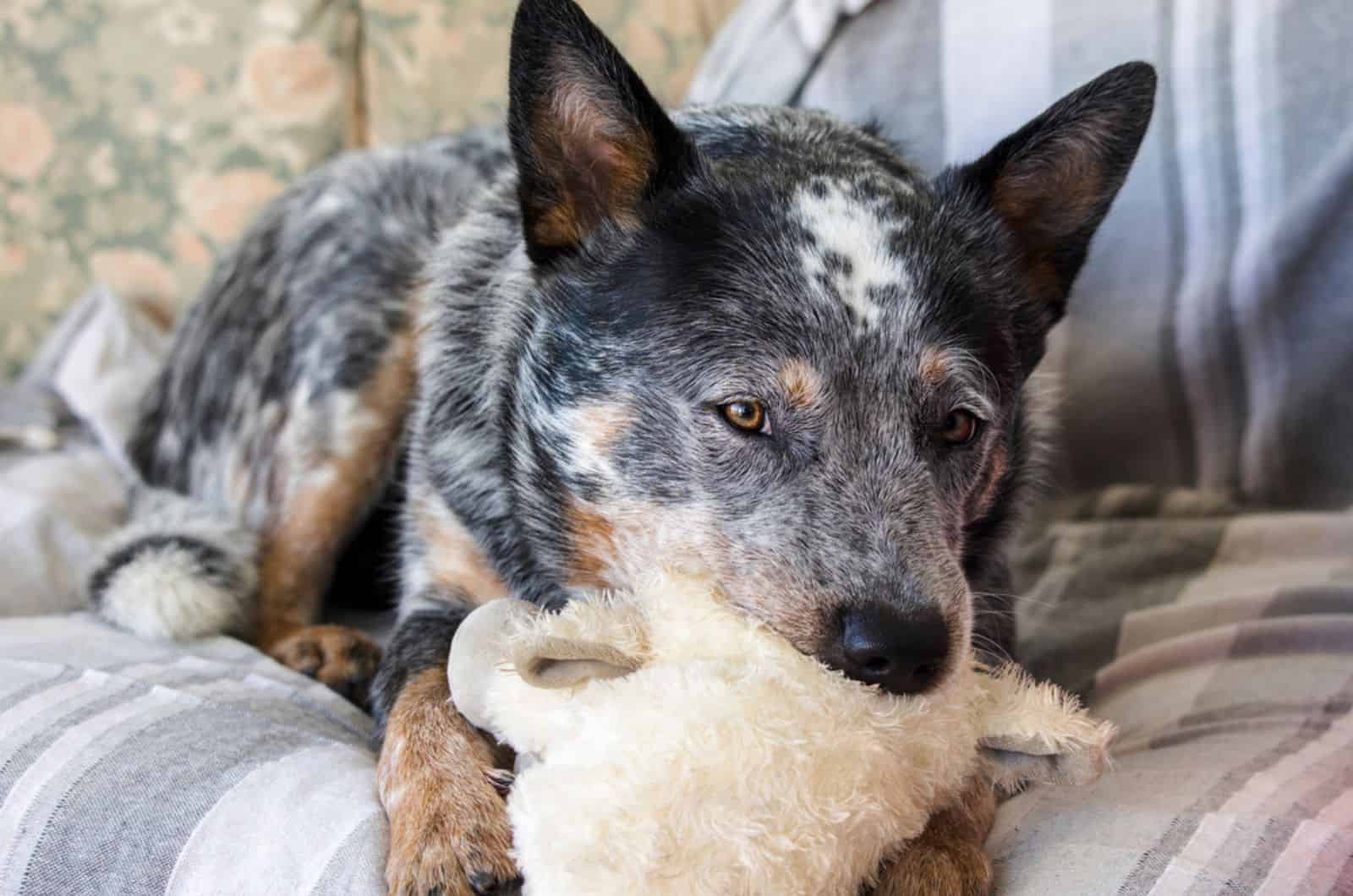
The Blue Heeler’s colors are not the only thing that makes these dogs so interesting and unique-looking. Their markings also play a big role.
The American Kennel Club accepts three types of coat markings on Australian Cattle Dogs. These regulations go hand in hand with other breed standard regulations such as the fact that they are pointy-eared dogs, that they have a long and bushy tail, along with their specific height, weight, etc.
A very important fact is that dogs without markings are equally accepted as those with them. But, there are not many Australian Cattle Dogs without any type of markings somewhere on their body.
1. Tan Markings
These markings appear on specific parts of the dog’s body according to the “tan” or “tan point” genes. These genes are present in other dogs as well.
These markings appear as tan patches. They can be different sizes and shades of tan. That means not every tan marking is the same shade of tan (pale brownish color). Sometimes, they can be very dark in color, and turn into red or black markings.
A dog that has “tan” genes has markings:
- Above the eyes (eyebrow tan patch)
- On the side of the cheeks
- On the side of the muzzle
- On the side of the neck
- On the chest (triangular shape)
- Inside the forelegs and hindlegs
- Underneath the tail
- On the edges or inside the ears
2. Black And Tan Markings
Very common types of markings on the standard Blue Heeler colors are black and tan markings. This dog also has “tan point” genes, but the tan markings often have a darker shade that somewhere turns into completely black patches.
These black markings are most commonly seen on the head and the tail. If they are on the head, they can be seen as eye patches on one or both eyes. The black patches usually spread to one or both ears as well.
Tan markings remain in the same locations as explained. The only difference is that there are now black markings in the same places as well.
What Is Considered Undesirable?
Just like with the Blue Heeler colors, there are certain rules that need to be followed when it comes to the coat markings as well.
The undesirable coat markings are:
- Black markings on the body
- Black markings on the entire muzzle
- Black saddle markings
3. Red Markings
The usual red-speckled Blue Heeler color is often followed by red markings on the head and the tail of the dog. These markings are normal, just as black and tan markings are normal for blue dogs.
The red markings can most commonly be seen as red patches around the eyes. They can be on one eye or both eyes, or covering almost the entire half of the dog’s head, including the ears.
These red markings can vary from dark red to light red. As long as they are not tan or any other color, they are permissible.
What Is Considered Undesirable?
The rules for the red markings on the red dog are not as strict as for the black markings on the blue dog. This is because the red color is not as distinctive on the reddish base as the black color is on the blue base.
But, red markings on these places are considered undesirable:
- Red markings on the body
- Big areas of red (an almost bi-colored dog)
- Red saddle markings
Interesting Facts About Blue Heeler Colors
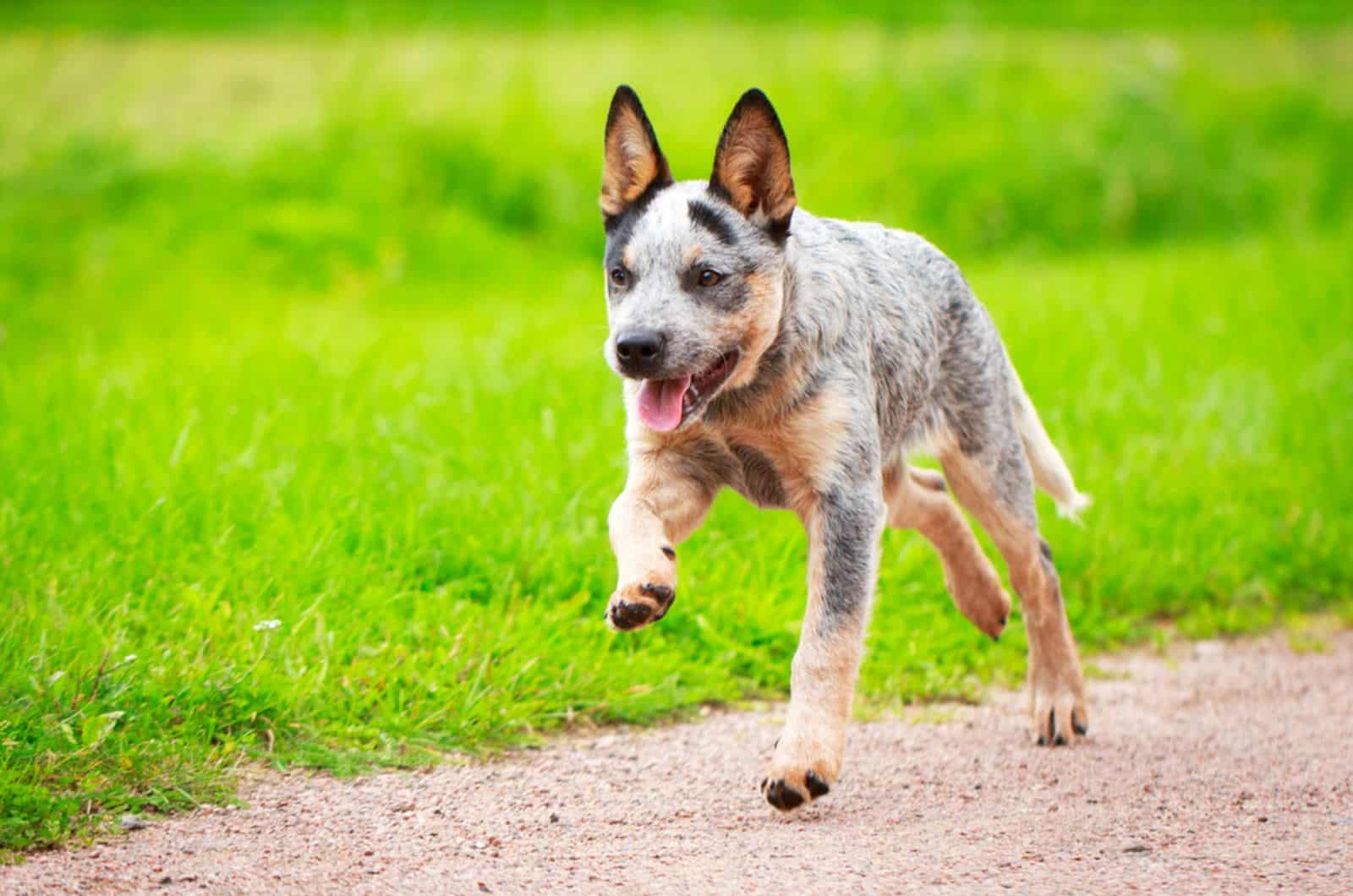
When it comes to the coat color of any dog, including the Blue Heeler colors — it’s all in the genes. Even though these dogs have a merle-colored ancestor in their gene pool, they don’t have a merling gene.
In fact, genes called roaning genes or ticking genes are responsible for such specific Blue Heeler colors and markings. For anyone who is more interested in genes, the roaning gene is on the T locus, and the merling gene is on the M locus.
These types of genes can be seen in the Australian Stumpy Tail Cattle Dog as well — a very similar dog breed to the Blue Heeler.
Here are some other interesting facts about Blue Heeler colors.
Born White
Yes, Australian Cattle Dog puppies are born as white heelers. They can have a black patch on their head or tail — and sometimes on their body.
These black patches on their body should disappear and turn into a blue coat color. But, the patches on their head or tail can stay on the dog for the rest of its life. Besides black, the puppies can also have red patches. Red patches are present on future red-speckled dogs.
Genes play the biggest role here. The dogs are born white, and they turn blue or red because of the ticking genes. Without these genes, the dogs would stay white.
This trait is obviously coming from their pretty-colored Dalmatian ancestor.
Raccoon Tail
The raccoon tail is the informal name of the ringed tail that a lot of Australian Cattle Dogs have. These white rings on their tail are present in both red and blue Heelers.
As long as the white markings are not making the entire tail white — it is not considered a fault. In most cases, dogs have white rings; hence, the name. But, these markings can be in the form of patches or smudges.
Some people believe that the raccoon tail trait also comes from the Dalmatian genes. But, because the smooth-haired Collie also has white markings, this cannot be considered to be the only solution to white markings on the Cattle Dog.
Bentley Mark
And, the last interesting fact about the lovely Blue Heeler colors is the fact that almost all Heeler dogs have a white patch on their forehead.
This marking is common in both red and blue Heelers, and it is completely normal. The name, “Bentley”, comes from a man named Tom Bentley, and his dog had this mark on its forehead. It is believed that he started breeding these dogs with such markings and made it a common trait.
The Bentley white mark can either be big or small, and of any shape. They are not considered an undesirable color or pattern trait.
The Conclusion
The Blue Heeler dog (or the Australian Cattle Dog) can have two base colors — red and black. These base colors are intertwined with white hairs, which divide all Blue Heeler colors into five groups. Add three more markings to that and we get a beautiful set of Heeler coat colors.
They are an easily-distinguishable dog breed, not just because of their unique color, but for their unique Dingo-like looks. This is where I have to point out that no matter how beautiful you think these dogs are — they are working dogs with Dingo genes.
That means they need proper socialization and dog training in order to keep them as well-behaved family pets. But, if you need a Heeler dog for work on a farm, there is no difference whether you choose a Blue Heeler, speckled red or speckled blue, etc.
They are all hard-working dogs, loyal, and smart. They will certainly add colors to your farm and do an incredible job of cattle herding at the same time.
